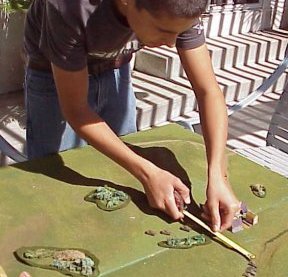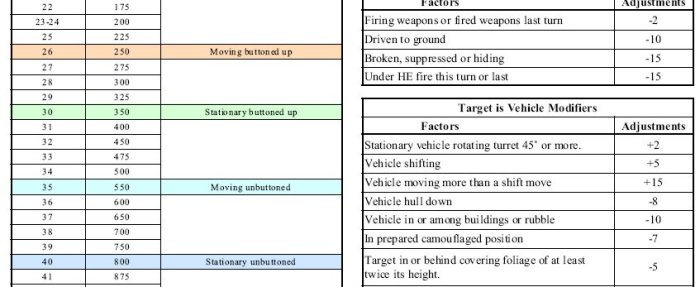|
Movement - Boot Camp |
||

|
In the movement phase of a turn the model vehicles are moved. Depending on the orders given at the beginning of the turn players move their tanks in a specific order. Tank platoons (and companies) that were given Charge, Rush or Bound orders go first. Tanks moving full must be moved over half their listed movement speed. |
||


|
The speed is listed as two numbers here. The first number is the cross county speed and the |
||
|
Sighting - Boot Camp |
||

|
After moving all of both sides tanks and other troops it comes time to determine if they can sight the enemy. Usually if something was sighted in the previous turn it will be automatically sighted or kept in sight if it didn't move away. There are exception an we will see one in the following example. |
||


|
Far left- British tanks sight. |
||


|
5. For the two moving Tigers: There is a narrow line of trees (10-15mm) between them and the British. For moving more than a shift move (+15) For hull down (-8). For seeing into or through foliage (-5). Size of target tank (+1 for size 1). Give a grand total of 43 factors. This equates to a visibility distance of 1025mm. |
||

|
This section of the Sighting Calculator show the four starting rows. The dark blue row is for an observer that is stationary and unbut |
||
|
7. The spotting tanks must make a variable sighting roll on a D10. There is only one roll made per spotting group no matter how many targets or groups of targets there are. To this die roll number the sighting group gets to add +1 for each friend (up to 4) helping sight. The roll is a '1'. But with +3 this goes to 4. On the variable sighting table this is one half normal visibility distance. The sighting distance for each situation is halved. Which means for the hull down Tiger group at 600mm away half of 1025mm (513mm) visibility distance and is not enough see them. But for the Mark IVs moving in the open at 850mm range half of 2200mm (1100mm) visibility distance is enough to see them. But what about when they get into the woods? Ordinarily they would not be seen moving into the woods if they hadn't first been seen moving there because one half of 800mm is only 400 and is not enough to see the 850mm to the woods. |
||